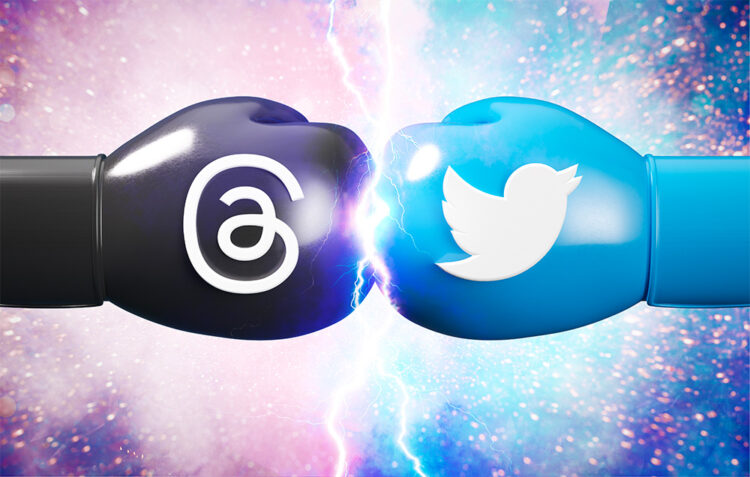Byebye Twitter, but jury still out on Threads

Opinion: 100% Media 0% Nonsense
The cultural moment for microblogging has passed and Twitter’s model was doubtful before Elon Musk came along. Threads, the Meta copycat, needs to innovate as well leverage Instagram’s scale, writes the editor.
Anyone who still uses Twitter will have seen that engagement rates have plummeted in recent weeks. It was already on the decline as users left the platform and service disruption began happening frequently (all thanks to the leadership decisions of Elon Musk).
With the launch of Threads by Instagram and yet another Musk debacle — the latest being an arbitrary limit being imposed on how many Tweets the majority of users can see — I can’t see any way for this company to meaningfully survive.
Yes, Musk can continue to prop it up as it racks up bigger and bigger losses, having already saddled Twitter with enormous debt after wildly overpaying. But for a company almost entirely reliant on ad revenue to lose 70% of its advertisers in the space of a year is unprecedented. And now the steady trickle of users leaving the platform is likely to be a full-blown exodus following the launch of Threads.
Many publishers will continue to promote their content on Twitter as usual but I’ve decided that The Media Leader will significantly reduce our activity on the platform from now on.
Yes, we’re rats leaving a sinking ship (or perhaps a tatty ocean liner that’s being steered to nowhere by a clown). But there’s another reason that all of us in this industry, especially publishers who invest time and resources into producing high-quality content, should be wary of Twitter or any copycat platform that ends up replacing it.
As I said on the day of its launch, I will not personally sign up for Threads. Leaving aside any misgivings about Meta (which are not the point of this article), the cultural moment for “microblogging” appears to have passed. When Twitter launched it was part of a whole wave of self-publishing that had become mature after everyone and his dog was doing a ‘blog’. The attraction was realising people have stuff to say but don’t want to write 800 words (I appreciate the irony of me asking you to write a longer piece).
It turns out that even coming up with one-liners on the regular is too much (or too pointless) for most people. Twitter has been around since 2006 and it’s still, for the most part, a preserve of celebrities, journalists, media professionals and corporations (one of which, Yorkshire Tea, unfairly drew LOLs after demeaning someone for “shouting at tea”).
Beyond the Twitterati, the only ‘real people’ who use Twitter regularly are performance artists, malcontents, chancers, bots and trolls. That’s why there is no genuine conversation with ‘real people’ as was envisioned. I suspect, as part of social media maturity, the more balanced among society are wise to this and want no part of it.
It’s more well-known how the insidious, addictive quality of social media encourages us to post often and hope beyond hope that our musings are validated by complete strangers. Wannabe performers choose quantity over quality. Outrage over consideration. Partisanship over understanding. Children and adolescents are particularly at risk, according to the US surgeon general in an extraordinary report in May.
‘Never significant’
Not only are the risks to society being better understood, but the business case for why Twitter fails seems straightforward. It cannot continue to rely almost entirely on ad revenue. Advertising needs a big audience when it is placed against low-quality content.
Don’t take my word for it: read, and then re-read, an op-ed by Yazmin King, a paid social director at digital marketing agency Croud: “Twitter has never played a significant role in our media plans for clients because Twitter lacks the media effectiveness and results to rival other major social platforms…. Whenever we have added it to a client’s media plan, it’s because we’ve exhausted all our other platforms.”
In other words: Twitter is the last nightclub still open at 3am. The weird fruit liqueur anomaly left in the chocolate box. If you’re advertising regularly on Twitter in 2023, then life in business has probably not panned out the way you think it probably should. And this is a vanishingly small number — ad sales have plunged 60% year-on-year, the New York Times reported last month.
If you’re a niche platform among celebrities and influential professionals, lean in to it. Be less reliant on advertising and charge the celebs and politicians with large followings to use the platform because their messages get more audience than the hoi pilloi. Create better ad inventory for luxury brands who want to reach affluent users. Turn ‘lack of scale’ into a strength i.e. be premium, exclusive, scarce.
Not sold on this Thread count
As for Threads, “premium” and “exclusive” are exactly the opposite of what Meta has offered by making it an Instagram spin-off. Instagram is a hugely successful social media product that, while not perfect, is visually compelling. But what it does have is scale (there are, according to estimates, now well over one billion active users on Instagram, three times what Twitter had at its peak).
Despite a mountain of commentary declaring Threads to be a runaway success before the end of week one, I’m yet to be convinced. How many existing Instagram users will end up posting on Threads very often? I think this largely depends on what features are rolled out in the coming weeks. I’m particularly pleased to see Meta commit to making Threads part of the fediverse and enable Meta users to connect and communicate with users on other platforms like BlueSky and Mastodon.
Without new features, you have to wonder what is really so different that will make Threads a long-term success where Twitter was not? Instagram has massive coattails and perhaps the incremental reach and engagement that Meta Ads gain with Threads will add up to serious additional ad revenue. That would be a great story to tell shareholders in the imminent round of quarterly earnings, which comes at an otherwise tough time for digital media.
Of course storytelling is what media is all about, social or not. All individuals have their own unique story to tell and social media can be the vehicle for giving a voice to the voiceless and unlocking new forms of creativity. But ask yourself this: if you could go back in time 20 years, would you try to launch Twitter?
 Omar Oakes is editor of The Media Leader and leads the publication’s TV coverage. ‘100% Media 0% Nonsense’ is a weekly column about the state of media and advertising. Make sure you sign up to our daily newsletter to get this column in your inbox every Monday.
Omar Oakes is editor of The Media Leader and leads the publication’s TV coverage. ‘100% Media 0% Nonsense’ is a weekly column about the state of media and advertising. Make sure you sign up to our daily newsletter to get this column in your inbox every Monday.




